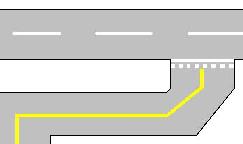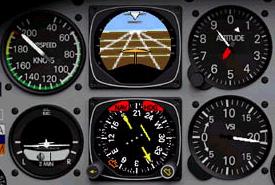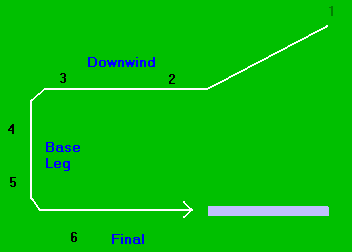FUIII Flight Training
Here I hope to provide summaries of the flight training included in FUIII. It's a shame you don't get this with the manual.
Basic Training
Taxi and Takeoff
- Start Engine (e) - check artificial horizon, oil temp/pressure come on
- Turn on Becon Light (')
- Turn on Taxi Lights (k)
- Take off parking brakes (b)
Other lights include Nav Lights (") Anti collision Lights (;) Pulse Lights (L) and Landing Lights (l)
- Throttle to 1000rpm to get moving
- Then moving throttle back to idle
- Use left and right rudder to steer (Cursors <- and ->)
- Brakes (Numpad Ins and Del)
- From main parking area taxi along yellow line
- Stop at hold short lines
- Radio to tower for clearance (Space Bar)
- Look right and left (Numpad <- and ->)
- Move onto runway
- Switch on Landing Light (l)
- Final takeoff check - (correct runway and direction, oil temp/pressure, fuel, instruments)

- Throttle to full
- At 55kias pull yoke (stick) back slightly to takeoff
- Climb at 10-12 degrees inclination, 70kias 1000ft/min (can look left and right to compare wings with horizon)
- Level off at 3000ft, power to 2400rmp, 100kias
- Trim out pressure i.e. ([) nose up (]) nose down
Fundamentals
- Cruise - Throttle at 2400 rpm, 110Kias - trim out pressure
- Bank Left - Yoke left, 30 degrees bank, pull up nose slightly
- Bank Right - Yoke right, 30 degrees bank, pull up nose slightly
- Climb - Throttle to full, airspeed reduces to 80kias - may need to compensate for loss of lift by pulling back yoke
- Level off - Slightly before desired altitude - Throttle to 2400 rpm, 110Kias - trim out pressure
- Descend - Throttle down to 2000rpm
Instrument Scanning
Airspeed, Artificial Horizon, Altitude

Turn Coordinator, Directional Gyro, Vertical Speed
Artificial Horizon is primary instrument, the rest are for backup.
Scan to compare with artificial horizon each instrument inturn.
Be aware of possible instrument failure...
e.g.
- Artificial Horizon & Directional Gyro - powered by engine driven vacuum pump, lost if engine fails
- Turn Coordinator - powered by electrical system. lost if broken or short ciruit, battery failure or master switch off.
- Airspeed, Altitude, Vertical Speed - powered by pitot static system, lost if pitot tube blocked
Traffic Patterns

Traffic pattern controlled airport - turn downwind, base, final
- 45 degree entry point, cruise speed, 1000ft AGL, 2400 rpm and flaps up
- Downwind 2000rpm, 90 kts, flaps up 1000ft
- Reduce to 1400rpm, 1 notch flaps and start descent, carbs heat on
- Speed at 75kts, 1400rpm, add 2 notches of flaps, altitude 700-500ft AGL
- Turn to final at around 500ft about 1.5 out at 70 kts, 1400rpm
- On final 60kts, 1400rpm, full flaps on short final
Standard Rate Turns
Keep IFR pilots out of trouble by limitting bank angles to 15 degrees so that
- you are less likely to get unintentional aerobatics
- airtraffic controllers can easily predict your position
Turns rate turns change direction by 3 degrees per second
hence it takes 2 minutes to turn 360 degrees.
Can use 3 degrees per second rule if directional gyro fails
When doing a standard rate turn

- Keep aeroplane lined up with side marking
- Keep ball in middle of slip indicator by using rudder correctly
Landings
Begin approach 2miles out at 600ft
Fly on 3 degrees glidepath
Align on centre line of runway to land between it's first 500 to 1000ft
Approach at 65kias by bringing power to 1500rmp and flaps full
When touching down 10ft from runway cut power to idel and ease nose up
Use Visual Approach Slope Indicator (VASI) to assist with glide path. This is a set of special signs at side of runway visible 4 miles out and 10 degrees alignment to runway

- White on White - high as a kit
- Red on White - youre alright
- Red on Red - youre dead
Advance Training
this page is under construction more to be added later
Weather Training
Aircraft Training





